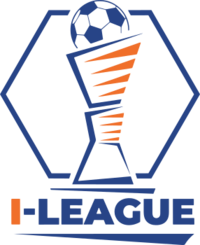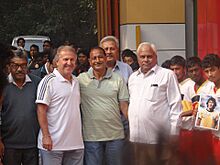I-League facts for kids
 |
|
| Organising body | AIFF |
|---|---|
| Founded | 2007 (as I-League; succeeding the National Football League) |
| Country | India |
| Confederation | AFC |
| Number of teams | 14 |
| Level on pyramid | 2 |
| Promotion to | Indian Super League |
| Relegation to | I-League 2 |
| Domestic cup(s) | Super Cup |
| League cup(s) | Durand Cup |
| Current champions | Inter Kashi (1st title) |
| Most championships | Dempo (3 titles) |
| Top goalscorer | Ranti Martins (214 goals) |
| TV partners | Sony Sports |
The I-League is India's second most important professional football league for men. It is just below the Indian Super League (ISL). The All India Football Federation (AIFF) runs the league. Currently, 13 clubs compete in it.
The league uses a system called promotion and relegation. This means the best team can move up to the ISL. The team that finishes last can be moved down to the I-League 2.
The I-League started in 2007. It replaced the old National Football League. The goal was to make Indian football more professional. It also aimed to find more talented players for the Indian national team.
Since it began, ten different clubs have won the I-League championship. Dempo has won the most titles, with three wins. Several other clubs, like Churchill Brothers and Gokulam Kerala, have won twice.
Contents
History
How It Started
Back in 1996, India started its first national league, the National Football League (NFL). The idea was to make football a professional sport in the country. However, the league had many problems. Clubs struggled with poor facilities and a lack of money.
After ten years, the All India Football Federation (AIFF) knew it was time for a big change. They decided to create a new, better league.
Creating the I-League
After the 2006–07 season, the NFL was officially replaced by the I-League. The first season kicked off in November 2007. It had ten teams: eight from the old NFL and two promoted from a lower division.
The league made new rules for foreign players. Each team could sign four players from other countries. Three could be from anywhere, but one had to be from an Asian country. This helped bring new skills and excitement to the league.
The first ten clubs in the I-League were Air India, Churchill Brothers, Dempo, East Bengal, JCT, Mahindra United, Mohun Bagan, Salgaocar, Sporting Goa, and Viva Kerala.
The Early Years (2007–2012)
The very first I-League match was on November 24, 2007. Dempo played against Salgaocar and won 3–0. At the end of the season, Dempo became the first-ever I-League champions.
The league grew quickly. For its second season, it expanded to 12 teams. By the third season, it had 14 teams. This expansion was important because it brought football to more cities across India, like Pune and Shillong. This helped make the league truly "national."
During this time, Indian football became more popular. The national team played in the AFC Asian Cup for the first time in 27 years. Players like goalkeeper Subrata Pal became famous for their great performances.
Indian players also started getting attention from clubs in other countries. Sunil Chhetri signed with a team in the United States, and other players had trials with clubs in Europe.
Becoming the Second Tier
In 2017, a big change happened in Indian football. The AFC, which governs football in Asia, worked with the AIFF to create a new plan. They decided that the Indian Super League (ISL) would become the top football league in India.
This meant the I-League became the second-division league. However, the plan included a path for I-League teams to reach the top. Starting in the 2022–23 season, the I-League champion could be promoted to the ISL. The goal is to eventually have a full system of promotion and relegation between the two leagues.
How the Competition Works
The I-League season is a round-robin tournament. This means each club plays every other club twice: once at their home stadium and once at the other team's stadium.
Teams get points for their matches: three points for a win, one for a draw, and zero for a loss. At the end of the season, the club with the most points is crowned the champion. The champion earns a promotion to the Indian Super League.
Clubs
Current Clubs
| Club | State/UT | City | Stadium | Capacity |
|---|---|---|---|---|
| Aizawl | Mizoram | Aizawl | Rajiv Gandhi Stadium | 20,000 |
| Chanmari | Mizoram | Aizawl | Rajiv Gandhi Stadium | 20,000 |
| Churchill Brothers | Goa | Margao | Raia Panchayat Stadium | 8,000 |
| Dempo | Goa | Panaji | Duler Stadium | 5,000 |
| Diamond Harbour | West Bengal | Diamond Harbour | Naihati Stadium | 25,000 |
| Gokulam Kerala | Kerala | Kozhikode | EMS Stadium | 50,000 |
| Namdhari | Punjab | Bhaini Sahib | Namdhari Stadium | 1,000 |
| Rajasthan United | Rajasthan | Jaipur | Vidhyadhar Nagar Stadium | 3,000 |
| Real Kashmir | Jammu & Kashmir | Srinagar | TRC Turf Ground | 11,000 |
| Shillong Lajong | Meghalaya | Shillong | SSA Stadium | 5,000 |
| Sreenidi Deccan | Telangana | Hyderabad | Deccan Arena | 1,500 |
Sponsorship
The I-League has had several title sponsors over the years. A title sponsor is a company that pays to have its name attached to the league.
- ONGC (2007–2011): The first sponsor was the Oil and Natural Gas Corporation.
- Airtel (2013–2014): The telecommunications company Airtel was the sponsor for one season.
- Hero (2014–2023): For many years, the motorcycle company Hero MotoCorp was the main sponsor, and the league was called the Hero I-League.
Since 2023, the league has not had a title sponsor.
Champions
Here is a list of the teams that have finished in the top three of the I-League each season.
| Season | Champions | Runners-up | Third place | Teams |
|---|---|---|---|---|
| 2007–08 | Dempo | Churchill Brothers | JCT | 10 |
| 2008–09 | Churchill Brothers | Mohun Bagan | Sporting Goa | 12 |
| 2009–10 | Dempo (2) | Churchill Brothers | Pune | 14 |
| 2010–11 | Salgaocar | East Bengal | Dempo | 14 |
| 2011–12 | Dempo (3) | East Bengal | Churchill Brothers | 14 |
| 2012–13 | Churchill Brothers (2) | Pune | East Bengal | 14 |
| 2013–14 | Bengaluru | East Bengal | Salgaocar | 13 |
| 2014–15 | Mohun Bagan | Bengaluru | Royal Wahingdoh | 11 |
| 2015–16 | Bengaluru (2) | Mohun Bagan | East Bengal | 9 |
| 2016–17 | Aizawl | Mohun Bagan | East Bengal | 10 |
| 2017–18 | Minerva Punjab | NEROCA | Mohun Bagan | 10 |
| 2018–19 | Chennai City | East Bengal | Real Kashmir | 11 |
| 2019–20 | Mohun Bagan (2) | Not Awarded | 11 | |
| 2020–21 | Gokulam Kerala | Churchill Brothers | TRAU | 11 |
| 2021–22 | Gokulam Kerala (2) | Mohammedan | Sreenidi Deccan | 13 |
| 2022–23 | RoundGlass Punjab | Sreenidi Deccan | Gokulam Kerala | 12 |
| 2023–24 | Mohammedan | Sreenidi Deccan | Gokulam Kerala | 13 |
| 2024–25 | Inter Kashi | Churchill Brothers | Real Kashmir | 12 |
Records and Awards
Top Goal Scorers
The player who scores the most goals in a season wins the Golden Boot award. Nigerian player Ranti Martins has won the award five times, more than anyone else. He also scored 32 goals in the 2011–12 season, which is the record for the most goals in a single season.
The most recent winner was David Castañeda for Sreenidi Deccan in the 2024-25 season.
Season Awards
At the end of each season, the I-League gives out awards to honor the best players and coaches. Some of the main awards are:
- Hero of the League: Given to the best overall player of the season.
- Golden Boot: For the top goal scorer.
- Golden Glove: For the best goalkeeper.
- Best Head Coach: For the top coach of the season.
- Emerging Player of the League: For the best young player.
See also
 In Spanish: I-League para niños
In Spanish: I-League para niños
- Football in India
- History of Indian football
- List of football clubs in India
- IFA Shield


